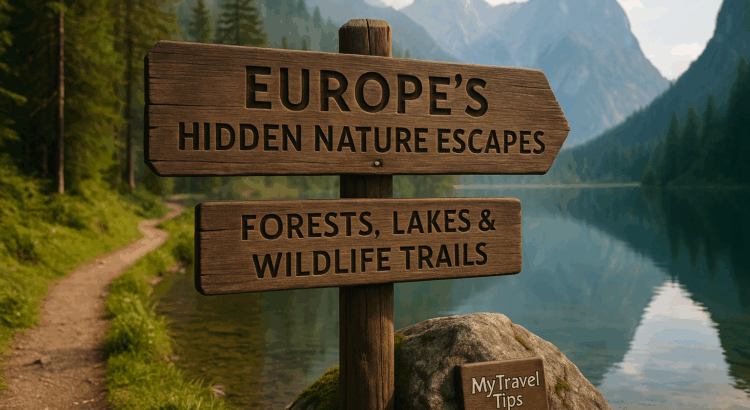Introduction – Why Hidden Nature Escapes Matter
With Europe becoming increasingly commercialized and crowded, more travelers are turning to quiet nature-based getaways. While urban hubs like Paris and Rome attract millions, some of the continent’s most rewarding travel experiences lie tucked away in national parks, alpine lakes, wildlife corridors, and old-growth forests.
From untouched valleys in Sweden to ancient mountain routes in Romania and tranquil Mediterranean forest trails in Greece, this guide uncovers Europe’s best hidden natural retreats — far from the crowds and closer to the wild.
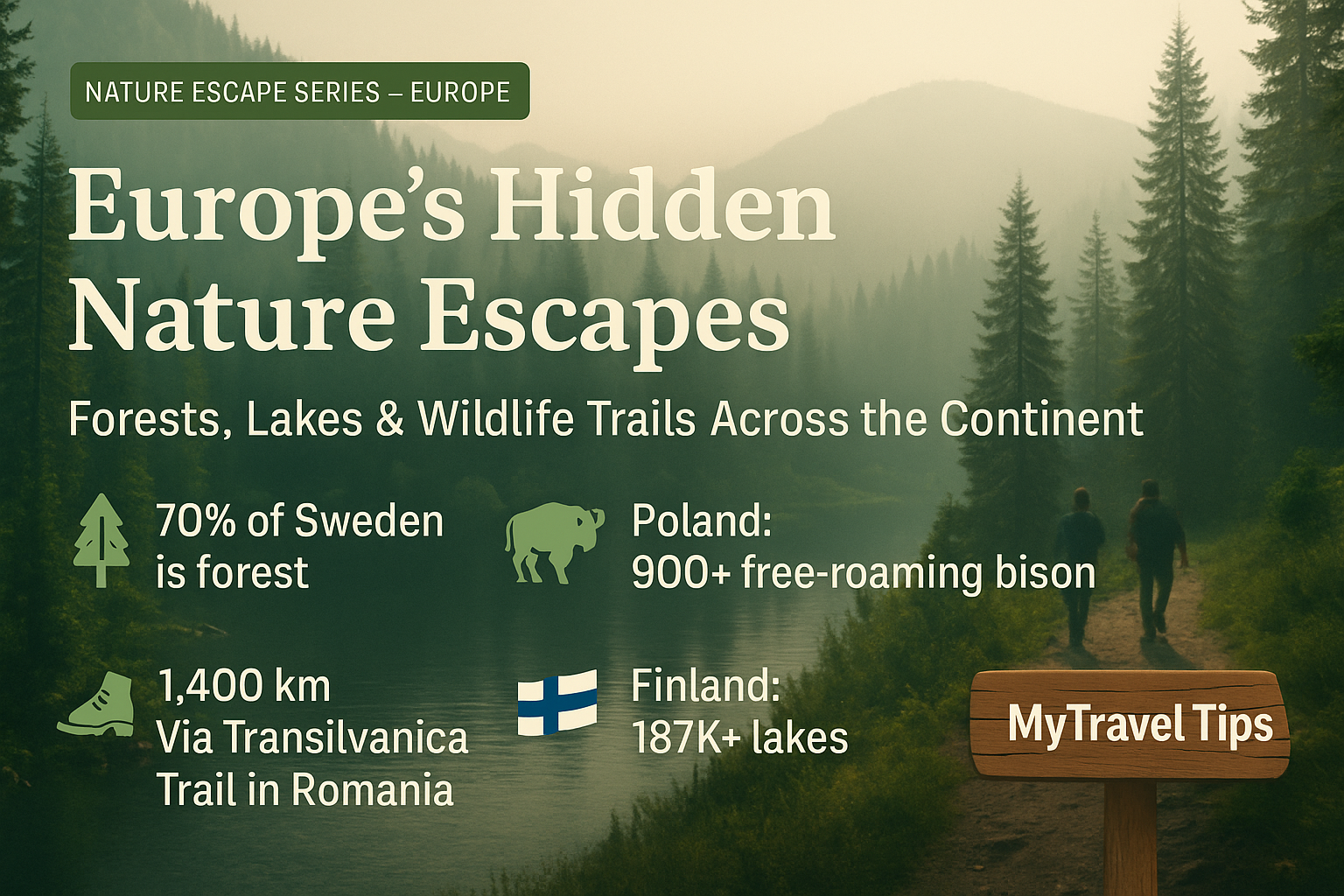
📸 Image: Peaceful forest path deep in Europe’s greenest zones – MyTravel Tips
🗂️ Article Overview
- Nordic Wilderness – Sweden & Finland ❄️
- Balkan Backwoods – Romania, Bulgaria, Montenegro 🏞️
- Mediterranean Nature Trails – Greece, Italy, Spain 🌳
- Forests and Lakes of Central Europe – Germany, Austria, Slovenia 🌲
- Best Wildlife Trails and Nature Watching Zones in Europe 🦌
- How to Travel Responsibly in Europe’s Natural Habitats 🧭
- Final Takeaways + Suggested Nature Getaways 📌
Nordic Wilderness – Sweden & Finland ❄️
Northern Europe is home to some of the continent’s most untouched nature. Sweden and Finland offer sprawling boreal forests, shimmering lake districts, and remote trails that stretch deep into Arctic silence. For travelers seeking solitude and connection with the elements, the Nordic region provides an unmatched escape.
One of the most iconic long-distance nature hikes in the region is Kungsleden, or “The King’s Trail”, which stretches over 400 km in Swedish Lapland. This trail offers stunning alpine valleys, wooden cabins, and the possibility to witness reindeer herds and midnight sun during summer.
Finland’s hidden nature escapes include the Nuuksio National Park near Helsinki and the Hossa National Park in the eastern wilderness. These offer tranquil forest paths, kayaking routes, and wildlife-watching cabins nestled in serene pine landscapes.
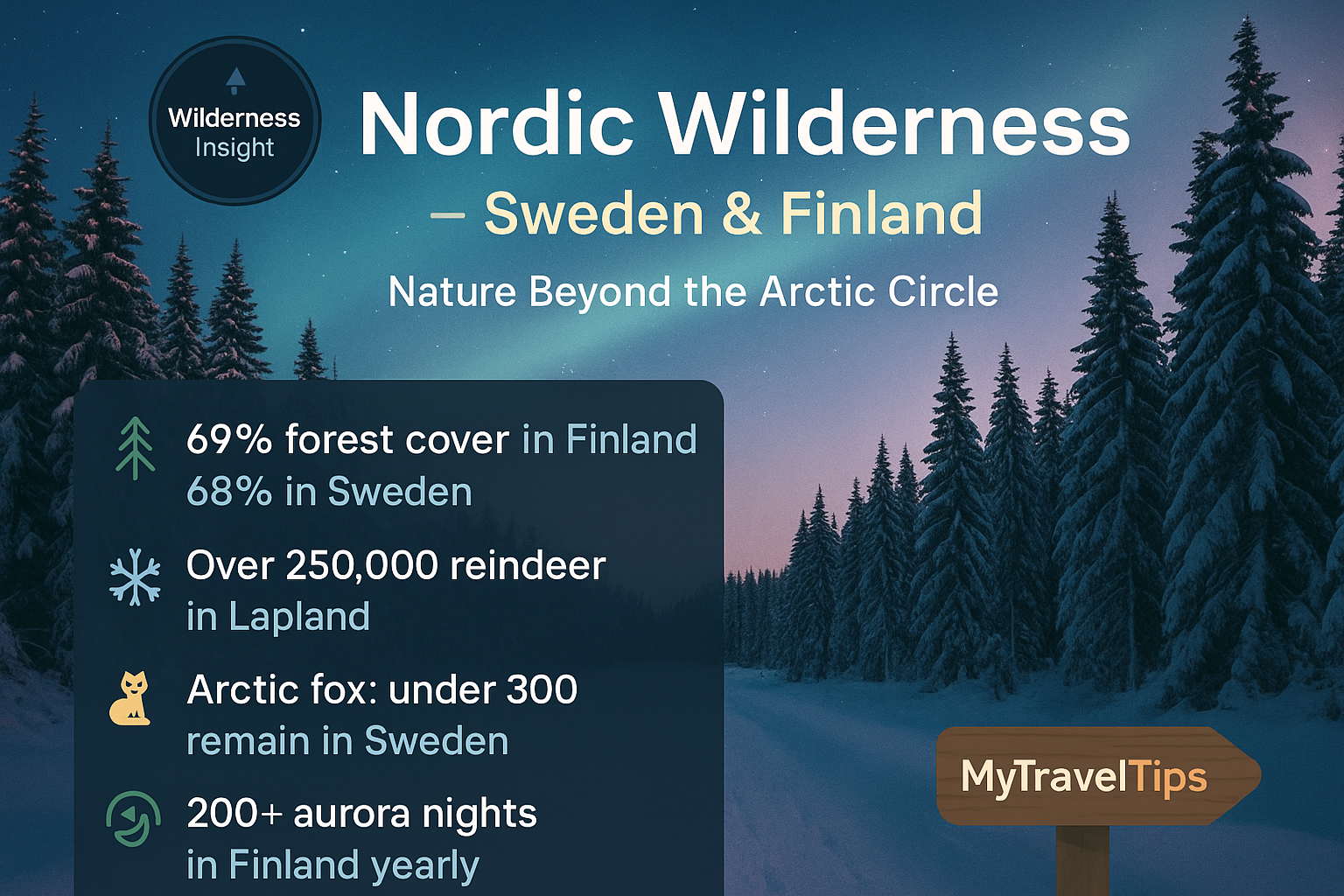
📸 Image: Alpine forest trail along the Kungsleden path, northern Sweden – MyTravel Tips
- 🌲 Sweden is 70% forested – one of the highest in Europe
- 🛤️ Kungsleden Trail: 400+ km across Lapland with STF huts & Arctic Circle views
- 🦌 Wildlife spotting: moose, reindeer, lynx, and golden eagles
- 🚣♂️ Finland’s “Land of a Thousand Lakes” has over 187,000 lakes
- 🏕️ Finland ranks #1 for nature-connected well-being (Eurostat, 2023)
💡 Travel Tip: Late June to early August is ideal for trail access, midnight sun, and open wilderness huts (STF system).
Balkan Backwoods – Romania, Bulgaria, Montenegro 🏞️
The Balkans hold some of the richest biodiversity and most undiscovered forest regions in Europe. From the dense Carpathian forests of Romania to the limestone gorges of Bulgaria and the highland lakes of Montenegro, this region invites nature seekers to truly get lost — in the best way.
Romania’s Via Transilvanica has rapidly emerged as a long-distance hiking favorite. Spanning over 1,000 kilometers, it winds through medieval villages, primeval woodlands, and UNESCO-protected reserves. Nearby, Bulgaria’s Central Balkan National Park offers dramatic rock formations, waterfalls, and over 1,300 plant species.
Montenegro’s Durmitor National Park is home to glacial lakes, ancient pine forests, and deep canyons carved by the Tara River. These protected lands offer excellent solo trekking, camping, and nature photography opportunities without the typical European foot traffic.
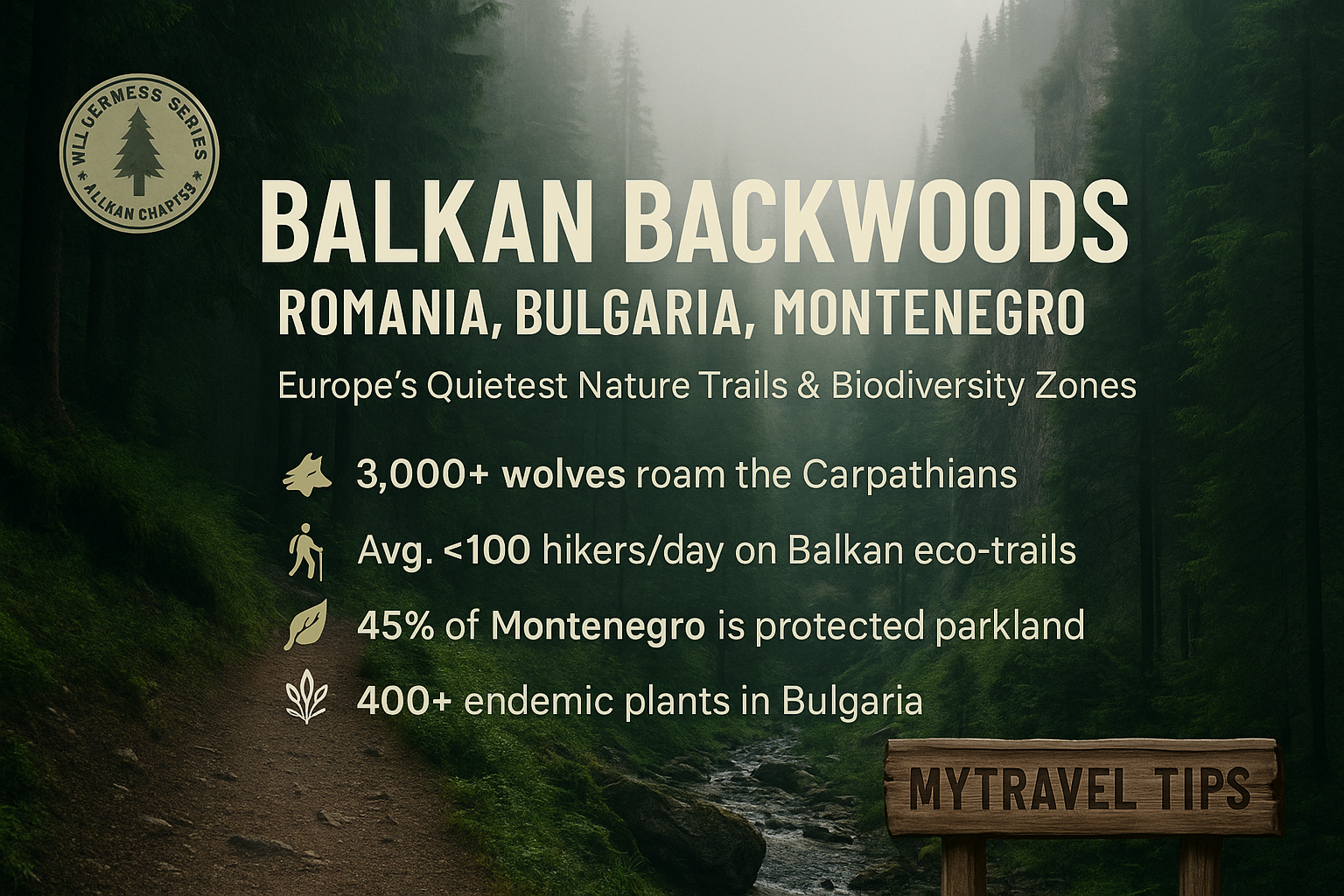
📸 Image: Quiet nature trail near the Carpathian foothills, Romania – MyTravel Tips
- 🌲 Via Transilvanica: 1,400+ km across 400 communities & 12 eco-zones
- 🦅 Central Balkan Park: Home to 70% of Bulgaria’s large bird species
- 🌄 Durmitor National Park: A UNESCO Biosphere Reserve with 18 glacial lakes
- 🧭 Balkan biodiversity: 80+ mammal species including lynx, bear & wolf
- 🥾 Low crowd trails: Average foot traffic is under 100 hikers/day (2023 surveys)
💡 Travel Tip: Autumn (late September to mid-October) is the best season for foliage views and crisp trekking weather in the Balkan forests.
Mediterranean Nature Trails – Greece, Italy, Spain 🌳
While the Mediterranean is best known for its beaches and coastal towns, the inland forest trails of Greece, Italy, and Spain offer equally captivating — and less explored — experiences. These routes are perfect for those who prefer dry woodlands, fragrant herbs, and ancient trails with millennia of history underfoot.
Greece’s Menalon Trail is one of the country’s certified long-distance routes, winding 75 km through Arcadian mountains, fir forests, and stone bridges. Italy’s Foreste Casentinesi National Park blends thick woodlands with historic monasteries nestled in the Apennines. Meanwhile, Spain’s Ordesa y Monte Perdido Park features dramatic cliffs, waterfalls, and old-growth pine ecosystems in the Pyrenees.
Whether you’re after shaded mountain paths or breezy cliffside walks, these Mediterranean escapes promise solitude, wildlife, and timeless scenery — all with fewer crowds than coastal hotspots.
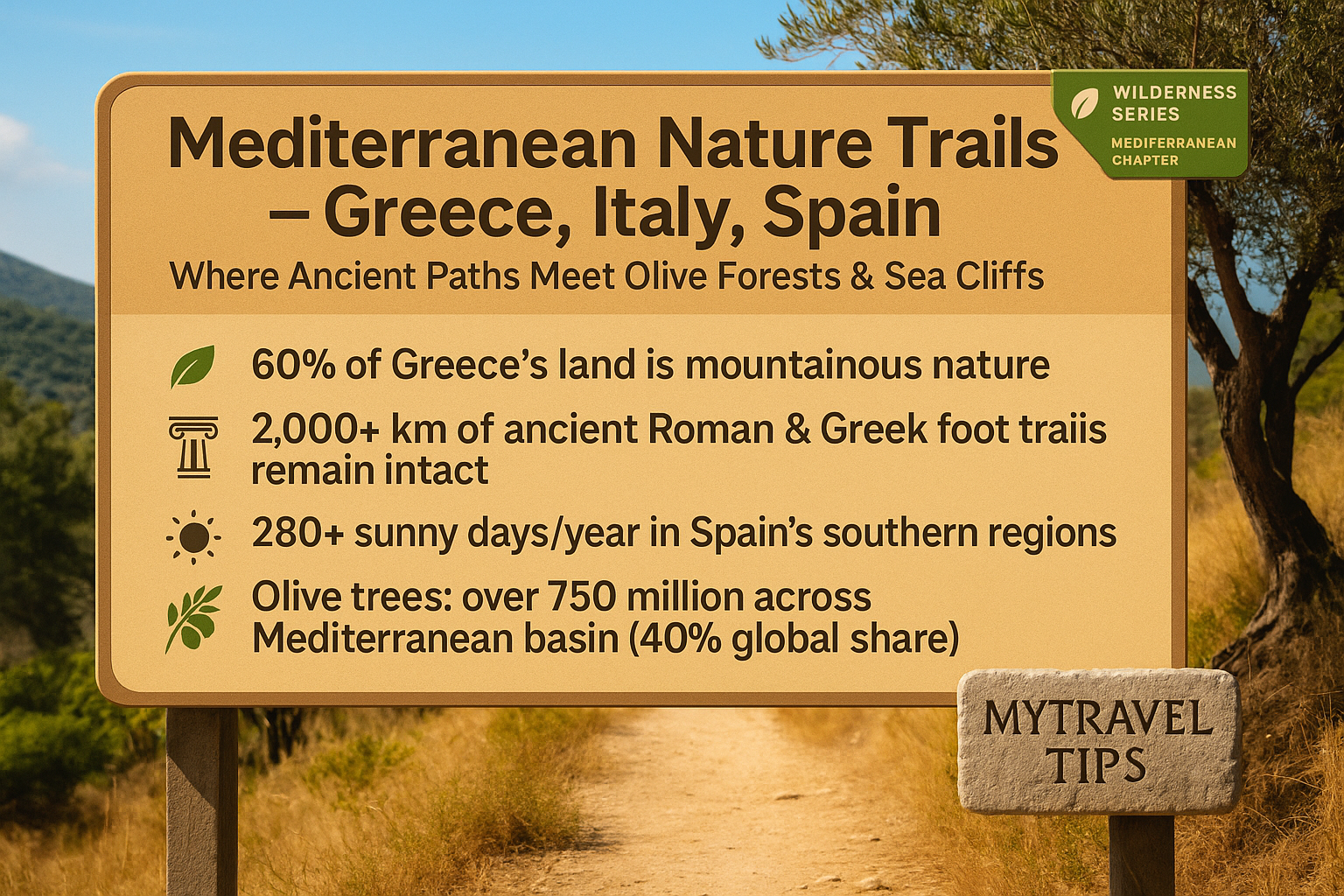
📸 Image: Quiet pine trail above a limestone canyon in Mediterranean Europe – MyTravel Tips
- 🏞️ Menalon Trail (Greece): 75 km marked route through 9 traditional villages
- 🌲 Foreste Casentinesi (Italy): One of Europe’s densest oak–fir forests
- 🦅 Monte Perdido (Spain): UNESCO Biosphere Reserve with 170+ bird species
- 🧘♂️ Perfect for: Slow trekking, forest meditation, and herbal foraging
- ⛱️ Shoulder seasons: April–May and September–October offer best climate
💡 Eco Tip: Avoid high summer due to fire risks and extreme heat. Stick to marked routes to protect native shrubs and soil biodiversity.
Forests and Lakes of Central Europe – Germany, Austria, Slovenia 🌲
Central Europe offers one of the most accessible combinations of pristine forests, calm glacial lakes, and family-friendly nature trails. If you’re looking for clean air, scenic reflections, and forest bathing without going too far from major cities — this region is your sweet spot.
In Germany, the Black Forest (Schwarzwald) has centuries-old woodland paths, cozy farmsteads, and lakes like Titisee, perfect for relaxed walking and biking. Austria’s Gosausee and Zell am See offer crystal-clear alpine lakes backed by pine-covered slopes and snowy peaks.
Slovenia, often overlooked, is a nature lover’s paradise — with Lake Bohinj and Triglav National Park offering some of Europe’s cleanest water bodies, surrounded by beech forests, waterfalls, and karst valleys.

📸 Image: Forest reflections at Lake Bohinj, Triglav National Park – MyTravel Tips
- 🏞️ Black Forest (Germany): Over 23,000 km of marked forest trails
- 💧 Lake Bohinj (Slovenia): Cleanest lake in the Julian Alps, ideal for kayaking & hiking
- 🧺 Zell am See (Austria): Year-round picnic spot with lakeside promenade
- 🌲 Triglav National Park: Home to 60% of Slovenia’s native species
- 🚗 Accessibility: All sites reachable within 2–3 hrs from major cities (Munich, Vienna, Ljubljana)
💡 Bonus Tip: Combine lake trails with thermal spa stops in Bavaria or alpine hut lunches in Salzkammergut for the full Central Europe experience.
Best Wildlife Trails and Nature Watching Zones in Europe 🦌
Europe may not be the first place that comes to mind for wildlife safaris, but its nature reserves are home to everything from wolves and wild bison to lynx, golden eagles, and brown bears. If you’re a slow traveler, photographer, or birder — these nature watching zones offer a quiet chance to observe animals in their native habitats.
The Carpathian Mountains stretching across Romania and Slovakia host the largest brown bear population in Western Europe. In Poland’s Białowieża Forest, you can spot rare European bison, while in the Pyrenees, you may come across ibex, vultures, and marmots along remote passes. Scandinavia’s Oulanka National Park in Finland and Sweden’s Sarek National Park are ideal for reindeer tracking and arctic fox sightings.
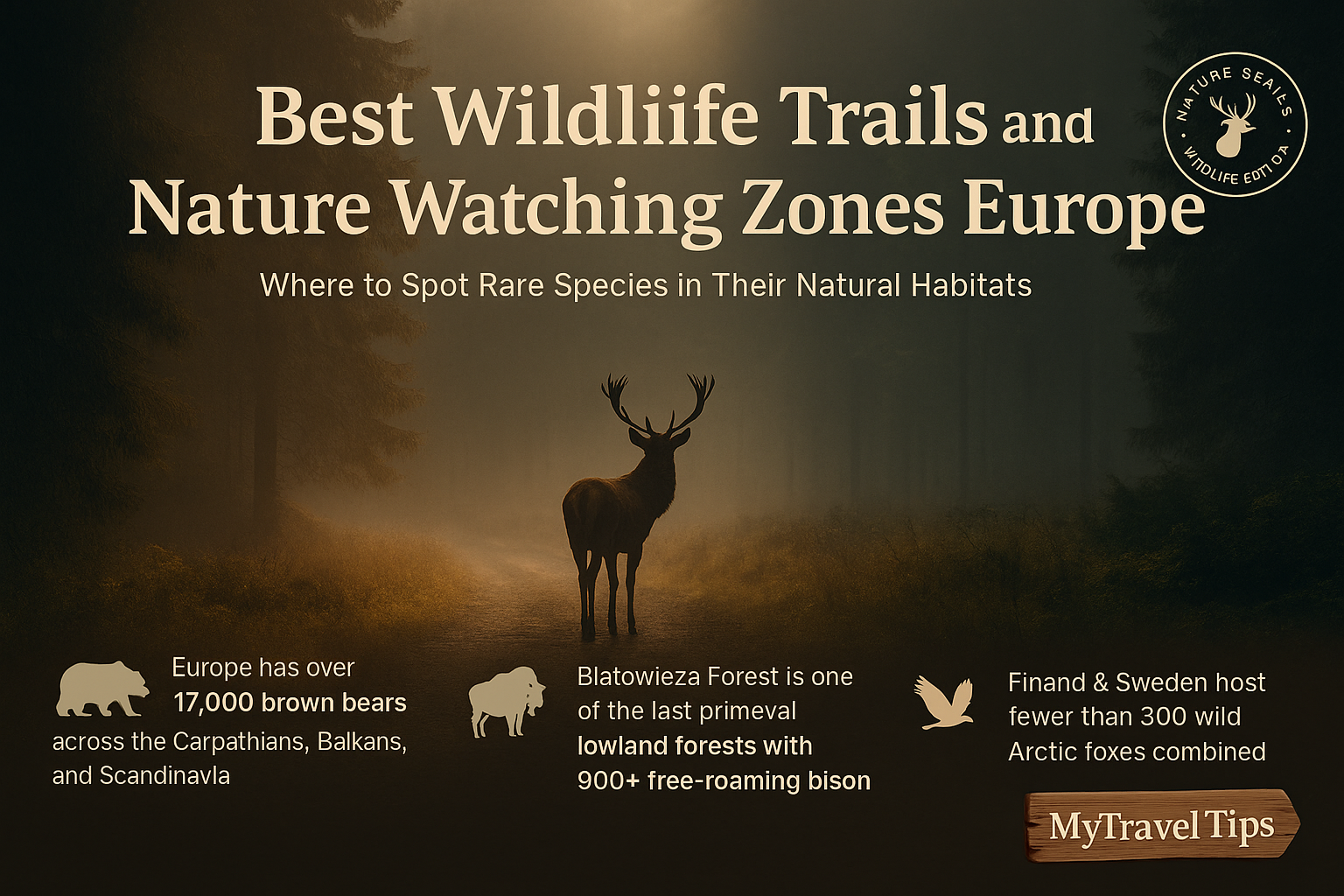
📸 Image: Dawn in Białowieża Forest – one of Europe’s last lowland primeval forests – MyTravel Tips
- 🧭 Romania’s Carpathians: Over 6,000 brown bears in protected regions
- 🐃 Białowieża (Poland): Last refuge of European bison (over 900 roaming freely)
- 🦅 Spanish Pyrenees: Home to golden eagles, griffon vultures & wild goats
- 🦊 Lapland & Arctic Finland: Reindeer migration zones & rare arctic fox dens
- 📸 Wildlife travel tip: Use local guides for best observation without disturbing habitats
💡 Insider Tip: Early morning or dusk are the best times for wildlife spotting. Silence, patience, and zoom lenses are your best friends in these regions.
How to Travel Responsibly in Europe’s Natural Habitats 🧭
With more people venturing into forests, lakes, and wildlife zones, the need for respectful, sustainable nature travel has never been higher. Europe’s parks and trails are often self-regulated — which means every traveler plays a role in protecting them for future generations.
Whether you’re hiking the Alps, exploring wetlands in Eastern Europe, or sleeping under stars in the Baltics, following a few golden rules can make your journey both ethical and enriching. Responsible travel helps minimize impact, supports local economies, and keeps fragile ecosystems safe.
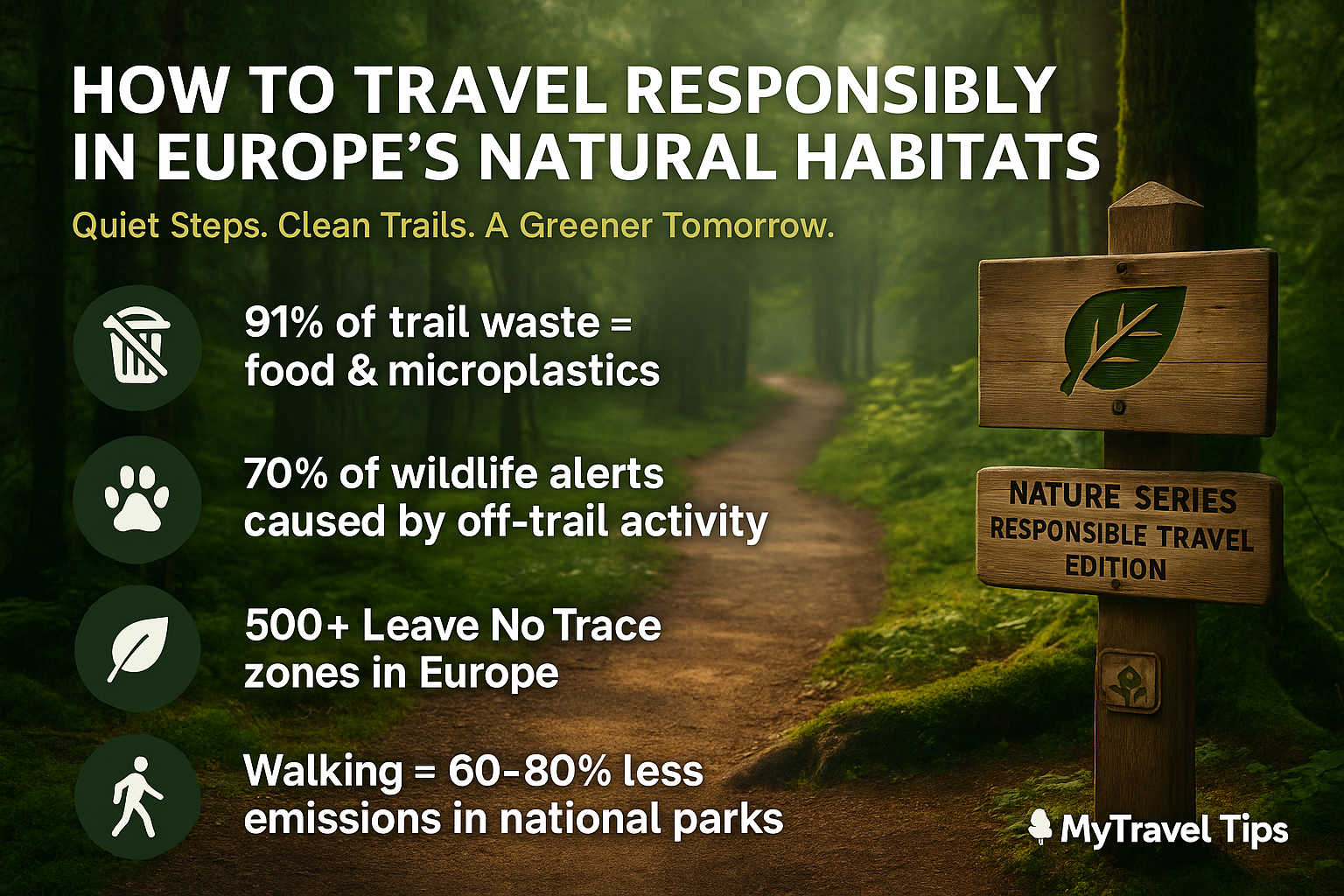
📸 Image: Trail markers and eco-guidance signs along a protected forest path – MyTravel Tips
- 🚯 Pack in, pack out: Leave no litter — even biodegradable food waste
- 🔥 No fire zones: Never light fires outside designated areas
- 🦉 Keep quiet: Respect wildlife and avoid loud noise in forests
- 🚶♂️ Stay on trails: Avoid damaging fragile plant life or nesting areas
- 🛖 Support local: Choose rural homestays, guides & eco-certified rentals
💡 Sustainability Tip: Consider using public transport or low-emission rail networks to reach nature destinations instead of rental cars.
Final Takeaways + Suggested Nature Getaways 📌
Whether you’re chasing pine forests, alpine lakes, or Mediterranean cliff trails — Europe offers every kind of nature experience if you know where to look. These lesser-known escapes aren’t just alternatives to touristy routes — they are journeys into a deeper, quieter, and more authentic side of the continent.
- 🧭 Most Immersive Trail: Via Transilvanica, Romania
- 🌲 Best Forest Vibe: Menalon Trail, Greece
- 💧 Top Lake Retreat: Lake Bohinj, Slovenia
- 🦅 Wildlife Spotting: Białowieża Forest, Poland
- ❄️ True Arctic Escape: Kungsleden Trail, Sweden
📚 You may also enjoy:
